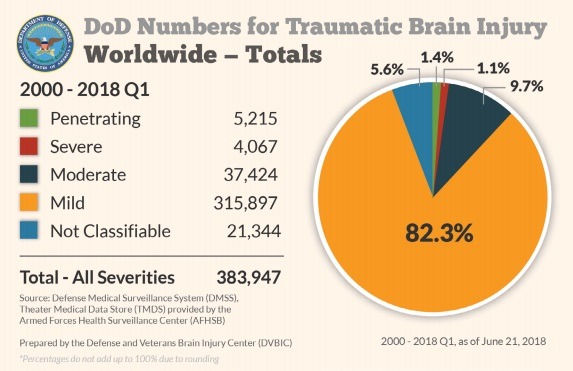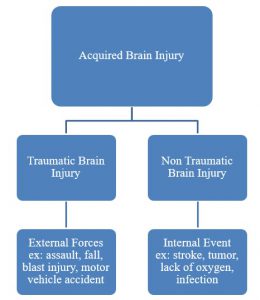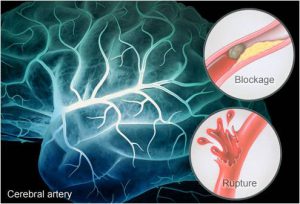What is a Brain Injury?
An Acquired Brain Injury (ABI) is any type of damage to the brain acquired after birth and which is not hereditary, congenital, or degenerative. Causes of ABI include external forces applied to the head and or neck (traumatic brain injury), anoxic/hypoxic injury (cardiac arrest, carbon monoxide poisoning, airway obstruction, hemorrhage, drowning), intracranial surgery, infectious diseases, seizure disorders, toxic exposure (substance abuse, ingestion of lead, inhalation of volatile agents), aneurysms, and vascular obstruction (stroke).
Colorado defines brain injury as: “Damage to the brain from an internal or external source, including, but not limited to, a Traumatic Brain Injury (TBI), that occurs post-birth and is noncongenital, nondegenerative, and nonhereditary, resulting in partial or total functional impairment in one or more areas, including but not limited to attention, memory, reasoning, problem solving, speed of processing, decision-making, learning, perception, sensory impairment, speech and language, motor and physical functioning, or psychological behavior” (Section 26-1-301(1.5), C.R.S.).
Brain injury affects the whole person, including changes in the physical, emotional, and cognitive areas of the body. These changes can impact how a person reacts to his or her daily life, including school and work, and how s/he manages his or her finances. Relationships and a person’s well being are determined by how well he or she can manage these challenges. The road can seem long and insurmountable, especially without help.
Wording courtesy of TX BIA
Anoxic Injury
When oxygen levels are significantly low for four minutes or longer, brain cells begin to die. After five minutes permanent anoxic brain injury can occur. Anoxic brain injury which is also called cerebral hypoxia is a serious, life-threatening injury; it can cause cognitive problems and disabilities. The term hypoxic means partial lack, whereas the term anoxic means total lack. The greater the loss of oxygen, the more wide-spread and serious the injury will be. Drowning, strangling, choking, suffocation, cardiac arrest, head trauma, carbon monoxide poisoning, and complications of general anesthesia can create conditions that can lead to cerebral hypoxia. Symptoms of mild cerebral hypoxia include inattentiveness, poor judgment, memory loss, and a decrease in motor coordination.
Brain Tumor
A brain tumor or intracranial neoplasm occurs when abnormal cells form within the brain. There are two main types of tumors: malignant, or cancerous, tumors and benign tumors. All types of brain tumors may produce symptoms that vary depending on the part of the brain involved. These may include headaches, seizures, problem with vision, vomiting, and mental changes. More specific problems may include difficulty in walking, speaking and with sensation
- American Brain Tumor Association – For nearly 40 years, the ABTA has been providing comprehensive resources that support the complex needs of brain tumor patients and caregivers, as well as the critical funding of research in the pursuit of breakthroughs in brain tumor diagnosis, treatment and care.
Cerebral Aneurysm
A cerebral aneurysm (also known as an intracranial or intracerebral aneurysm) is a weak or thin spot on a blood vessel in the brain that balloons out and fills with blood. The bulging aneurysm can put pressure on a nerve or surrounding brain tissue. It may also leak or rupture, spilling blood into the surrounding tissue (called a hemorrhage). Some cerebral aneurysms, particularly those that are very small, do not bleed or cause other problems. Cerebral aneurysms can occur anywhere in the brain, but most are located along a loop of arteries that run between the underside of the brain and the base of the skull.
- Brain Aneurysm Foundation – The mission of the Brain Aneurysm Foundation is to provide support networks and educational resources to raise public awareness regarding early detection and treatment of brain aneurysms.
- The Aneurysm and AVM Support Page – The purpose of this Aneurysm and AVM Support site is not to echo data from many other informative web pages, but to instead be a place for survivors, their families, and those who have lost loved ones to aneurysms to exchange experiences and pre- and post aneurysm diagnoses.
Encephalitis
Encephalitis is irritation and swelling (inflammation) of the brain, most often due to viral infections. Encephalitis can cause flu-like symptoms, such as a fever or severe headache. It can also cause confused thinking, seizures, or problems with senses or movement.
- Encephalitis Information Resource – This site provides comprehensive information and resources for those affected by encephalitis.
Epilepsy and Seizures
- National Epilepsy Foundation – The Epilepsy Foundation’s goal is to ensure that people with seizures are able to participate in all life experiences. They also believe in preventing, controlling, and curing epilepsy through research, education, advocacy, and various services.
- Epilepsy Foundation of Colorado
- State Driving Laws – Here you can review the laws for driving with epilepsy in your state or compare laws between states if you are moving.
Stroke
A stroke occurs when a blood clot blocks an artery or a blood vessel breaks, interrupting blood flow to an area of the brain. When either of these things happen, brain cells begin to die and brain damage occurs.
When brain cells die during a stroke, abilities controlled by that area of the brain are lost. These abilities include speech, movement and memory. How a stroke patient is affected depends on where the stroke occurs in the brain and how much the brain is damaged.
For example, someone who has a small stroke may experience only minor problems such as weakness of an arm or leg. People who have larger strokes may be paralyzed on one side or lose their ability to speak. Some people recover completely from strokes, but more than 2/3 of survivors will have some type of disability. -National Stroke Association
- Stroke kills almost 130,000 Americans each year—that’s 1 in every 18 deaths.
- On average, one American dies from stroke every 4 minutes.
- Every year, more than 795,000 people in the United States have a stroke. About 610,000 of these are first or new strokes. One in four are recurrent strokes.
- Ischemic strokes happen when blood clots block the blood vessels to the brain. About 87% of all strokes are ischemic.
- Stroke costs the United States an estimated $54 billion each year. This total includes the cost of health care services, medications, and missed days of work.
- Stroke is a leading cause of serious long-term disability.
Resources:
- American Stroke Association – This is a division of the American Heart Association that provides outreach, promotes research, and publishes a journal. The site includes facts and a guide for women.
- National Stroke Association – The National Stroke Association is a national voluntary health care organization focusing on stroke prevention, treatment, rehabilitation, and research for stroke survivors/families.
- Rocky Mountain Stroke Center
- Acute Stroke Toolbox
- National Institute of Neurological Disorders and Stroke (NINDS) – The National Institute of Neurological Disorders and Stroke (NINDS) is the leading supporter of biomedical research on disorders of the brain and nervous system.
- Stroke Awareness for Everyone – Established in 1995, this organization provides information and support to stroke survivors and their families and friends. Caregivers can read a four-chapter handbook from the website.
- The Stroke Network – This is an online stroke support and information group designed to help everyone in the stroke family. Their stroke support group is available 24/7, and the purpose of their organization is to provide online support for adult stroke survivors and caregivers.
What is a Traumatic Brain Injury?
A Traumatic Brain Injury (TBI) is defined as a blow or jolt to the head or a penetrating head injury that disrupts the function of the brain. Not all blows or jolts to the head result in a TBI. The severity of such an injury may range from “mild,” i.e., a brief change in mental status or consciousness to “severe,” i.e., an extended period of unconsciousness or amnesia after the injury. A TBI can result in short or long-term problems with independent function.
How many people have TBI?
Data from CDC
- Approximately 223,135 TBI-related hospitalizations in 2019 and 64,362 TBI-related deaths in 2020 in the United States.
- These estimates do not include the many TBIs that are only treated in the emergency department, primary care, urgent care, or those that go untreated.
- People age 75 years and older had the highest numbers and rates of TBI-related hospitalizations and deaths. This age group accounts for about 32% of TBI-related hospitalizations and 28% of TBI-related deaths.
- Males were nearly two times more likely to be hospitalized (79.9 age-adjusted rate versus 43.7) and three times more likely to die from a TBI than females (28.3 versus 8.4).
- Children (birth to 17 years old) had 16,070 TBI-related hospitalizations in 2019 and 2,774 TBI-related deaths in 2020
Groups at greater risk
Anyone can experience a TBI, however some groups are at greater risk of dying from a TBI or experiencing long-term health problems after the injury. Examples include
- Racial and ethnic minorities
- Service members and Veterans
- People who experience homelessness
- People who are in correctional and detention facilities
- Survivors of intimate partner violence
- People living in rural areas
According to the Defense Centers of Excellence, almost 400,000 military personnel have sustained a brain injury since 2000

Colorado Data:
- Colorado ranks 9th in the nation of fatalities due to a TBI and 13th in the nation of hospitalizations due to a TBI
- Almost 5,000 individuals are hospitalized and nearly 1,000 die due to a TBI in Colorado each year
- 23,500 emergency room visits each year are due to a TBI
- Males are twice as likely to sustain a TBI in Colorado as females
- The age groups with the highest risk of sustaining a TBI in Colorado are 15-24 and 65+
- Each year, 2,200 individuals continue to experience disability one year after hospitalization for a TBI
Traumatic Brain Injury National Data Center
- Craig Hospital recently published research demonstrating the incidence of brain injuries & commonly reported symptoms in different regions of the state.
This document is a large version the data, which includes regional as well as statewide numbers. For more information about this research, please contact Gale Whiteneck, PhD, Principal Investigator: Gale@craig-hospital.org or CB Eagye, Research Associate: PEagye@craighospital.org
What causes TBI?
The leading causes of TBI are:
- Falls (47%)
- Motor vehicle-traffic crashes (14%)
- Struck by/against (15%)
- Assaults (11%)
- Other/Unknown (13%)
Blasts are a leading cause of TBI for active duty military personnel in war zones.
Who is at highest risk for TBI?
- Males are about 1.5 times as likely as females to sustain a TBI.
- The two age groups at highest risk for TBI are 0 to 4 year olds and 15 to 19 year olds.
- Certain military duties (e.g., paratrooper) increase the risk of sustaining a TBI.
- African Americans have the highest death rate from TBI.
Concussions by High School Sport
Total Reported Concussions Between 2005 and 2016 = 8,043
 American Journal of Public Health
American Journal of Public Health
What are the costs of TBI?
Direct medical costs and indirect costs such as lost productivity of TBI totaled an estimated $60 billion in the United States in 2000.
What are the long-term consequences of TBI?
The Centers for Disease Control and Prevention estimates that 6 million Americans currently have a long-term or lifelong need for help to perform activities of daily living as a result of a TBI.
According to one study, about 40% of those hospitalized with a TBI had at least one unmet need for services one year after their injury. The most frequent unmet needs were:
- Improving memory and problem solving
- Managing stress and emotional upsets
- Controlling one’s temper
- Improving one’s job skills
TBI can cause a wide range of functional changes affecting thinking, language, learning, emotions, behavior, and/or sensation. It can also cause epilepsy and increase the risk for conditions such as Alzheimer’s disease, Parkinson’s disease, and other brain disorders that become more prevalent with age.
For more information or details about TBI statistics, please visit:
- Centers for Disease Control and Prevention – Nationwide TBI statistics.
- Shaken Baby Alliance – Here you can learn about the devastating effects of Shaken Baby Syndrome.
- Traumatic Brain Injury Model Systems Program – This program consists of a group of 17 programs across the United States that work to gather data on brain injury rehabilitation.
Online Education:











